Case 5 Report: Learning to Write in an Oraganization
Case 5
Report
Learning to Write in an Organization
The Situation
You have accepted a technical-communication internship at the Washington, DC headquarters of the U.S. Energy Information Administration (EIA). The EIA, the statistical and analytical agency of the U.S. Department of Energy, provides data and information on energy sources. The EIA publishes reports, Web products, press releases, databases, and maps. Publications are issued weekly, monthly, quarterly, annually, and as needed or upon request.
As an intern, you will work closely with Merilee Summerfield, a technical publications editor. “Our Web site is the primary communication channel for the EIA,” Merilee explains. “We’ve just launched the first phase of a comprehensive site redesign that will affect the way we write Web content. Using a uniform style throughout our site tells users that the EIA has high standards for our content and our data.” She has asked you to develop Web content and to help scientists as they write various EIA documents.
When writing Web content, EIA writers follow recommendations from The Energy Information Administration’s Web Editorial Style Guide. The guide specifies details of the writing style required by the EIA, including rules for punctuation, word usage, tone, and hypertext links. The guide also contains direction on matters related to EIA work specifically, such as editorial voice, capitalization of frequently used words and terms, abbreviation of units of measure, and notes.
The Challenge
Learning to write in a new organization involves a learning curve. You will experience part of this learning curve when you are asked to quickly learn about the EIA and what represents consistent, correct, readable Web content within that organization. You will also have to grapple with unfamiliar content. As you study model documents, consider their audience and purpose, become knowledgeable about their contents, and familiarize yourself with the EIA’s Web Editorial Style Guide, you will learn how to adapt your writing to meet the specific needs of an organization.
Your Job
During your first week as an EIA intern, you will need to learn about EIA publications and Web editorial guidelines. As a new intern, you may be asked to do the following:

To download electronic copies of documents in this chapter, click here.
- Study a preface to a technical report to learn the characteristics of the organization’s reports.
- Contrast a printed report to a report designed for online use, and evaluate their features.
- Learn about appropriate content and level of detail for an energy report.
- Use the organization’s style guide to answer writing-related questions posed by analysts.
Your instructor will tell you which of the tasks you are to complete.
You can view case documents at the bottom of each task below. To download copies of the documents that you can work with, click here.
Get started on your job.
Task 1 Learn about an Organization’s Reports
First, Merilee would like you to learn about EIA, and, in particular, what EIA writers want to accomplish with their energy publications. She suggests that you start by reading “Our Work” under the heading “About EIA” on the EIA site at www.eia.gov/about/eia_explained.cfm (Figure 5.2) and explore other links on the site such as “Mission and Overview” (Figures 5.3 and 5.4). To introduce you to EIA publications, Merilee asks you to study a preface (Document 5.5) and write a two-page memo in which you do the following: (a) describe the preface’s audience and purpose; (b) evaluate how well the preface explains the subject, purpose, background, and scope of the report; (c) describe and evaluate the preface’s organizational structure; and (d) discuss the preface’s level of formality and voice (active or passive). To get you started, Merilee has provided brief marginal notes.

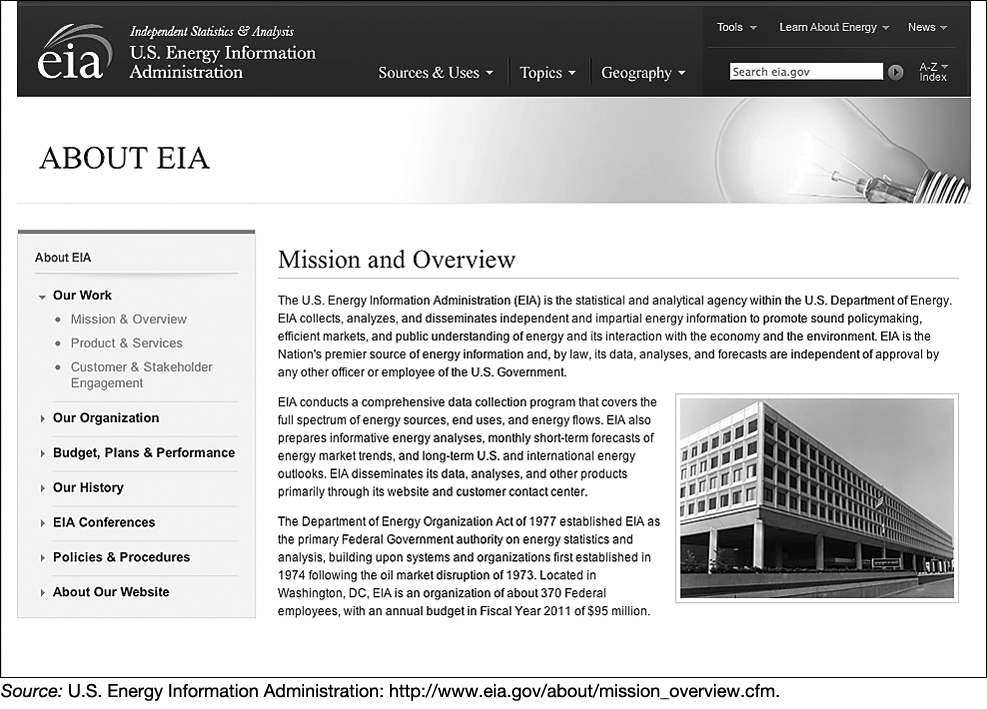
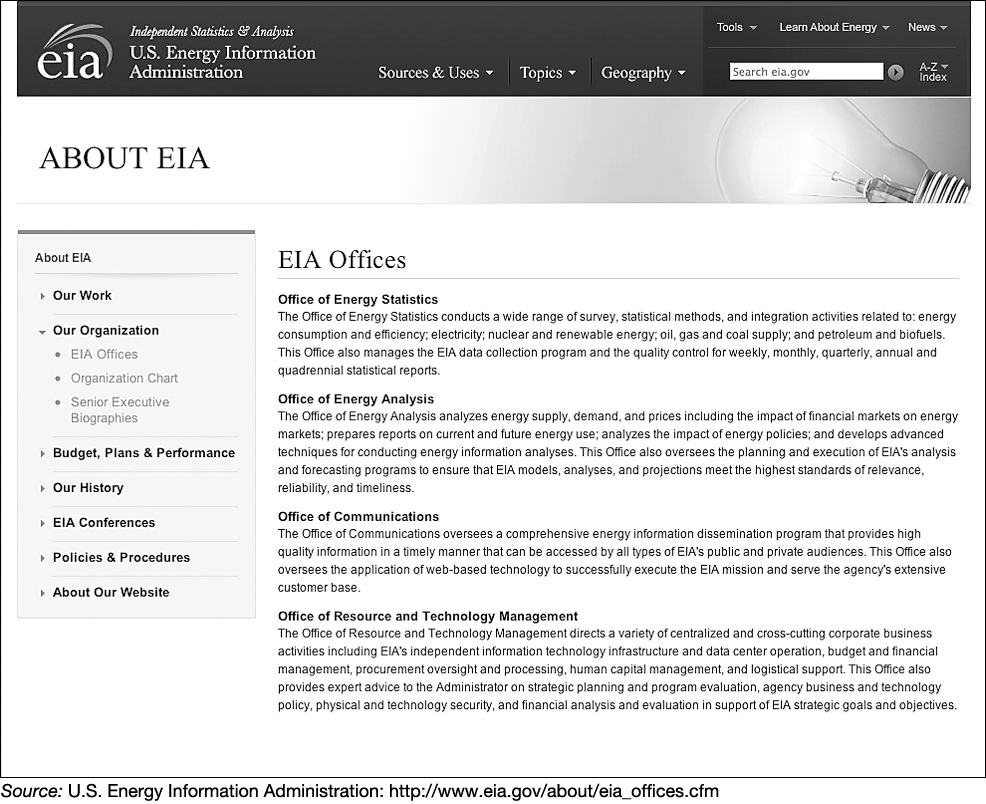
At the EIA, we label some of our introductory sections as prefaces and place them in the front matter of the report. Note lowercase Roman numeral pagination (e.g., ix and x). Other organizations place introductions in the body of the report.
We provide our readers with a concise, one-sentence description of our report.
An overview of how data are grouped in the report.
A statement of methods used to make projections.
A statement of types of energy not included in this report.
Because this “disclaimer” is so important, we placed it in a shaded box.
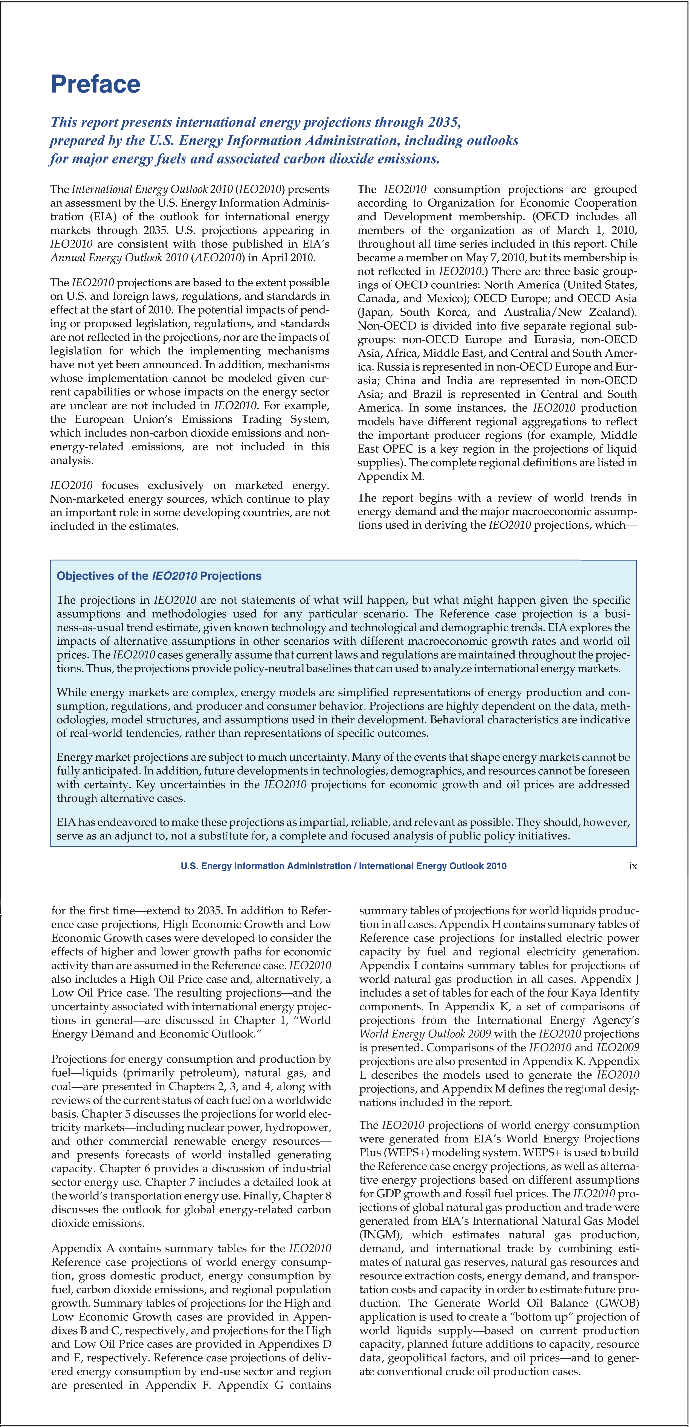
DOCUMENT 5.5
Preface from International Energy Outlook 2010
Beginning at the bottom of page ix, we include a detailed advance organizer in these three paragraphs.
This last paragraph includes more discussion methods. Do you think ending the preface with a paragraph on methods is effective?
Task 2 Compare and Evaluate Report Designs
To help you better understand how the communication medium will affect the way the content is presented, Merilee asks you to take a closer look at three different designs for the organization’s annual International Energy Outlook (IEO) report Documents 5.6, 5.7, and 5.8). In the margins, she has posed questions to help you focus on the different designs. Respond to her questions in a brief memo.
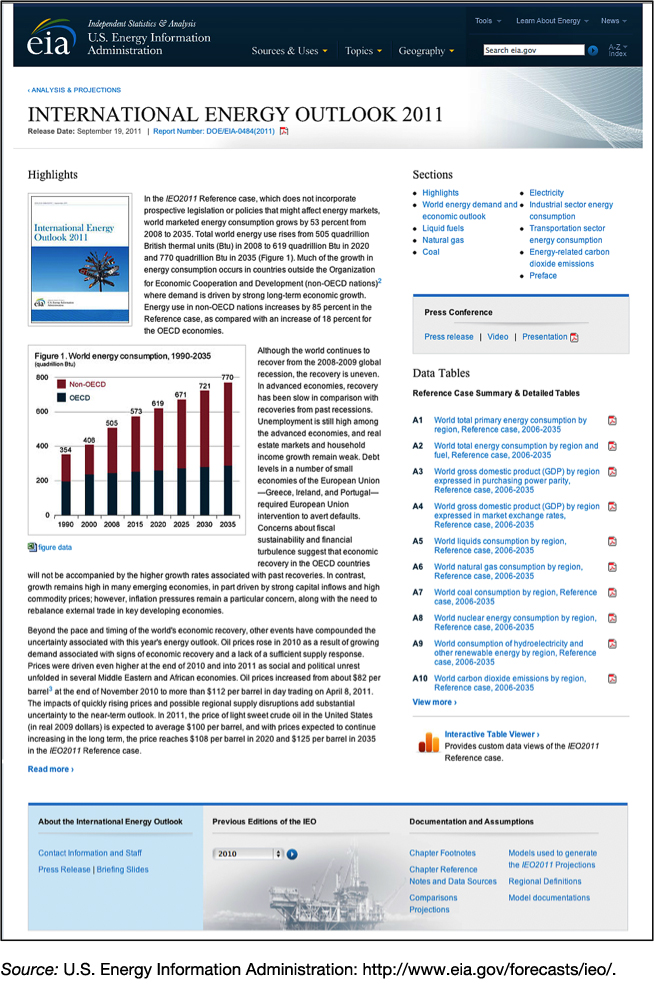
What navigation aids are available on this page to help readers quickly find the content they seek?
What types of readers might use the hyperlinks to data tables and the Interactive Table Viewer?
In what ways are these links to related content useful to readers?
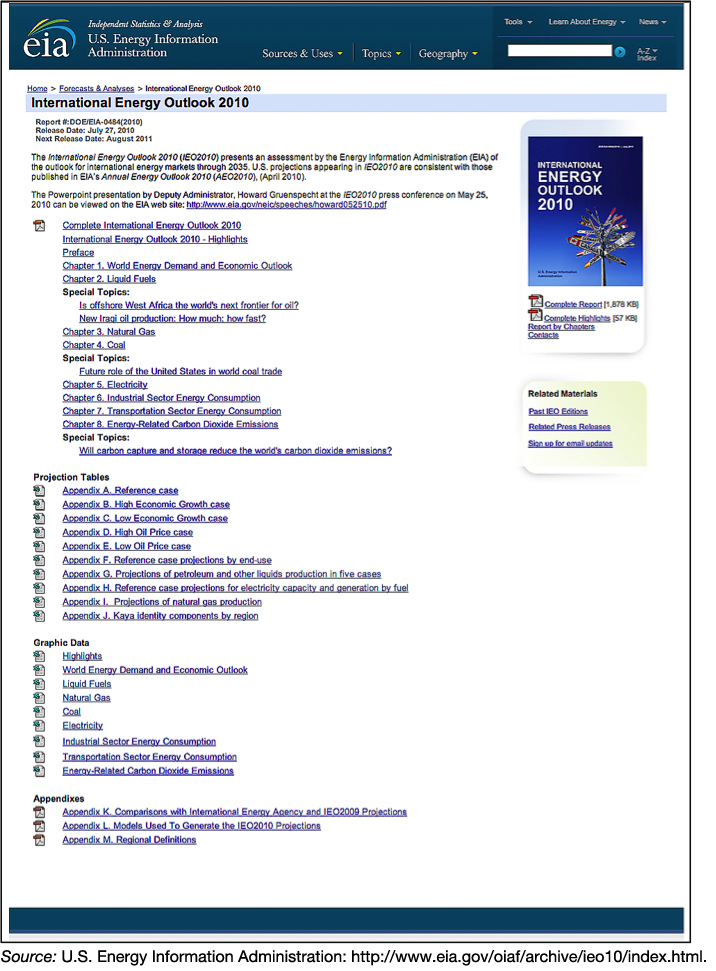
This page displays an archived IEO report. In what ways does this page display content and related resources differently from the page displaying the most recent report (Document 5.6)?

What navigation aids are not available in a printed report?
How has the writer designed this page to be printed and read?
What interactive features are not available in a printed report?
Task 3 Learn about Appropriate Report Content
To help you gain a better understanding of appropriate content and level of detail when reporting energy information, Merilee asks you to take a closer look at three excerpts focusing on carbon dioxide emissions Documents 5.9, 5.10, and 5.11) from a report on emissions of greenhouse gases in the United States. In the margins, she has posed questions to help you focus on the characteristics of the selections. Respond to her questions in a brief memo.
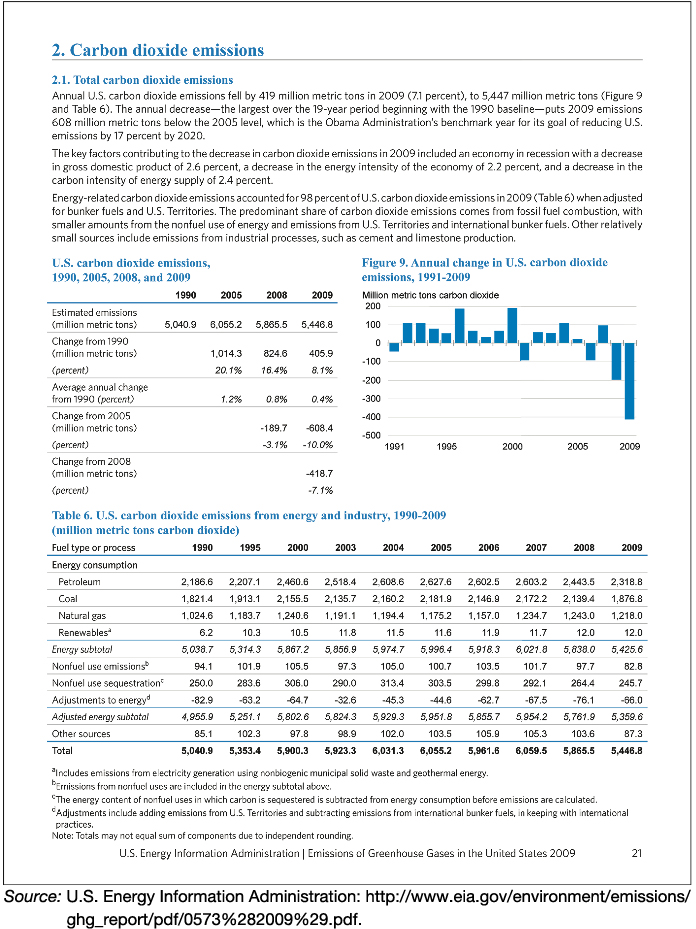
DOCUMENT 5.9
Page from Greenhouse Emissions Report
Study the text sections on the next three pages. What types of information are discussed in these sections?
Why is it important for readers to understand the key factors contributing to the decrease in carbon dioxide emissions?
Why do you think our reports rely so heavily on graphics?
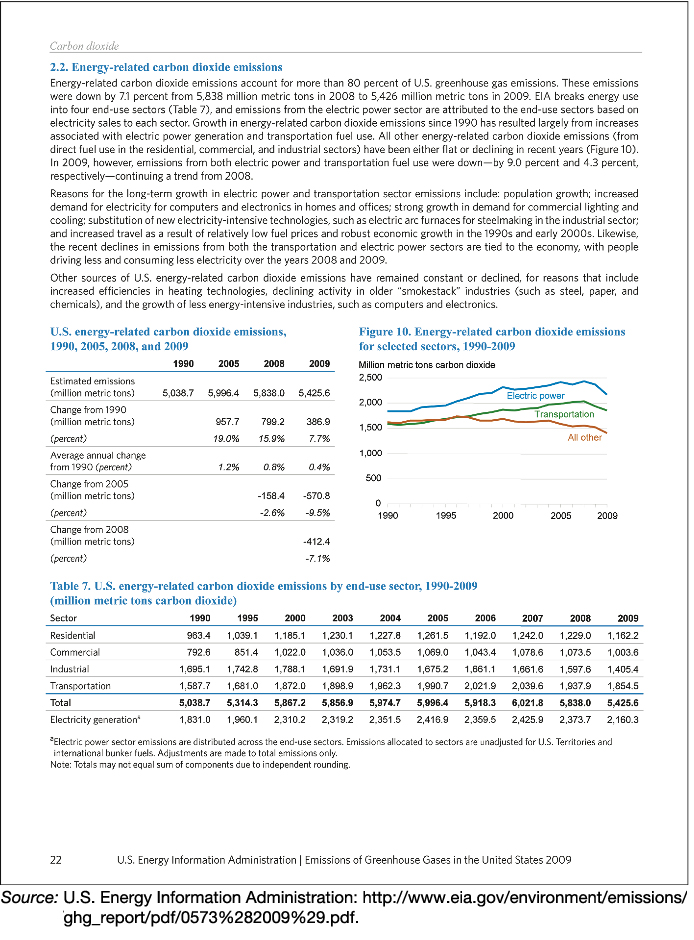
DOCUMENT 5.10
Excerpt on Energy-Related Carbon Dioxide Emissions from Greenhouse Emissions Report
Identify the strategies the writers use to integrate the graphics with the text.
What types of information do the graphics on this page communicate more effectively than the text above them?
Because our writers frequently use tables, I’d like you to become familiar with the parts of a table. Can you identify and list elements that make these tables effective?

DOCUMENT 5.11
Excerpt on Residential-Sector Carbon Dioxide Emissions from Greenhouse Emissions Report
How would you describe the level of detail and tone of the text? Why do you think the writers included the details that they did?
Why do you think the writers used two bulleted lists here?
Based on these three pages, describe how graphics and text are arranged on a page.
Task 4 Use an Organization’s Style Guide
Merilee would like your help responding to two emails (Documents 5.12 and 5.13) from EIA analysts. Because the analysts follow the EIA’s Web Editorial Style Guide when writing reports, she wants you to consult relevant sections of the guide when responding to their queries. In both forwarded messages, she directs you to the appropriate sections of the guide. The Web Editorial Style Guide is available online at http://www.eia.gov/about/eiawritingstyleguide.pdf. Write Merilee an email with your responses to each message.
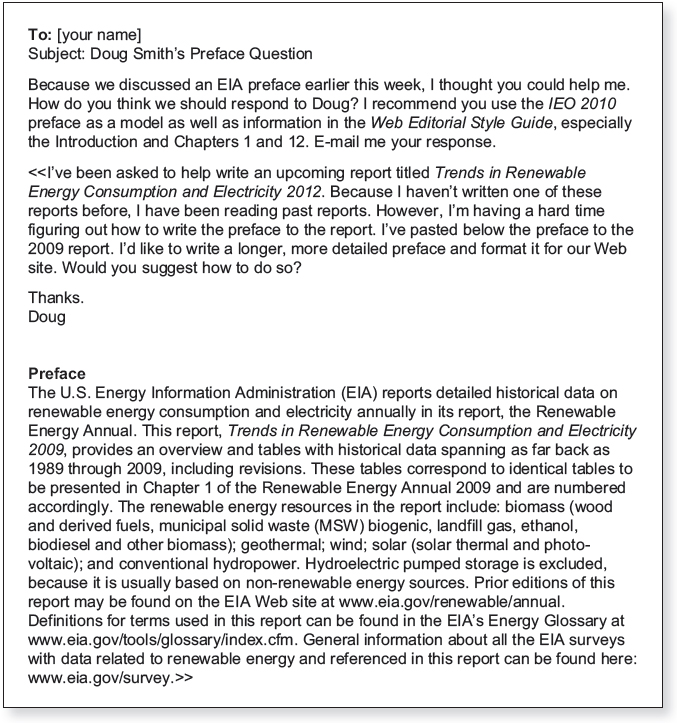

When You’re Finished
Reflecting on This Case In a 250- to 500-word response to your instructor, discuss (a) what you learned from this case, (b) how you could relate this case to work situations you will face in your chosen career, and, if applicable, (c) the ways in which this case compares to similar situations you have already faced at work. Your instructor will tell you whether your response should be submitted as a memo, an email, or a journal entry, or in a different format.
Moving beyond This Case Locate a professional who spends a significant amount of his or her time writing at work and is willing to be interviewed. You may choose to interview someone from your chosen field or a different profession. Investigate how this professional learned about writing for his or her particular organization. You might ask the following:
- What types of documents do you regularly write for your employer?
- How did writing in college differ from writing in your organization?
- What did you need to learn about writing in your organization? How did you go about learning it?
- Did anyone within the organization help you? If so, who, and in what ways did they help?
- What advice do you have for new employees learning to write?
Present your findings in a report to your instructor.